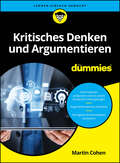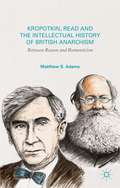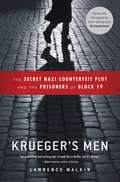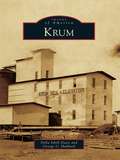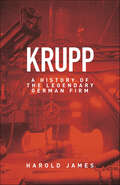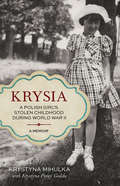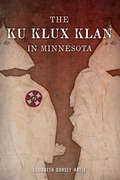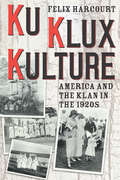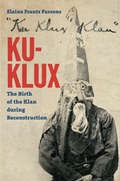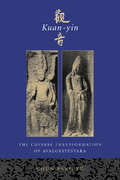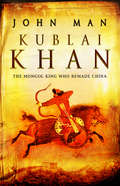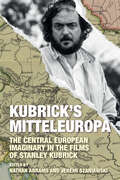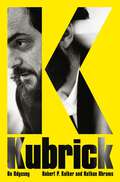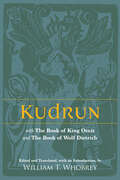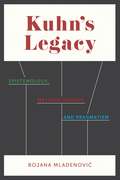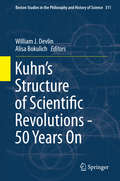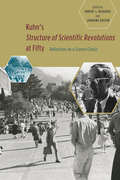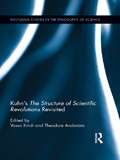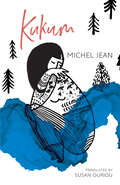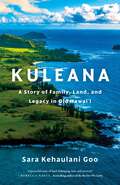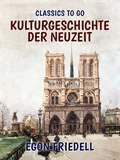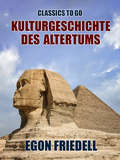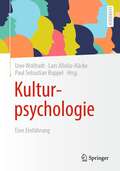- Table View
- List View
Kritisches Denken und Argumentieren für Dummies (Für Dummies)
by Martin CohenEinfach gut argumentieren Kritisches Denken – die Fähigkeit, sich einen Überblick ??ber eine Situation oder ein Thema zu verschaffen, Informationen gezielt zu analysieren und sich dann ein fundiertes Urteil zu bilden – ist ??beraus wichtig in einer von vielen als un??bersichtlich empfundenen Zeit. Martin Cohen f??hrt Sie in dieses aufregende Thema ein und ergänzt die theoretischen Grundlagen um Beispiele und Übungen f??r die praktische Anwendung. Das Buch hilft Ihnen, Ihre Fähigkeit zu reflektierendem Denken zu entwickeln, Ihren Sinn f??r kritische Analysen zu verbessern und effektive Argumente herauszuarbeiten. Sie erfahren Was einen guten kritischen Denker ausmacht Wie Sie das kritische Denken und Argumentieren in der m??ndlichen und schriftlichen Praxis anwenden Wie Sie typische logische Fallstricke erkennen und vermeiden
Kropotkin, Read, and the Intellectual History of British Anarchism
by Matthew S. AdamsAlthough marginal as a political force, anarchist ideas developed in Britain into a political tradition. This book explores this lost history, offering a new appraisal of the work of Kropotkin and Read, and examining the ways in which they endeavoured to articulate a politics fit for the particular challenges of Britain's modern history.
Krueger's Men: The Secret Nazi Counterfeit Plot and the Prisoners of Block 19
by Lawrence MalkinThe true story that inspired the Oscar-winning movie The Counterfeiters. "An astonishing and exciting tale. The drama of how the Nazis mounted a complex counterfeiting operation inside a concentration camp is matched by the chilling life-or-death saga of the prisoners involved. It reads like a thriller, but it's all true." -Walter Isaacson, author of The Wise Men and Benjamin FranklinOnly a fortnight after the start of WWII, at a meeting that has remained a secret for more than half a century, Nazi leaders and officials of the German Reichsbank approved an audacious plot to counterfeit millions of British pounds. Drawing upon top-secret bank records, German and British correspondence, and interrogation transcripts, Lawrence Malkin reveals how an unremarkable SS officer named Bernhard Krueger attempted to bring down the world financial system. But when Krueger discovered that forging pounds, and later dollars, was no easy task, he made a crucial decision: he would seek out the greatest counterfeiters of pre-war Europe and enlist them in the effort. He found them in an unexpected place: a Nazi concentration camp. KRUEGER'S MEN is the remarkable story of how these Jews managed to save themselves. Part Schindler's List, part The Great Escape, this account of the Nazi plot is a fascinating portrait of deception, courage, and moral awakening. "Few writers understand the mysterious intricacies of money better than Lawrence Malkin, and in KRUEGER'S MEN he has reconstructed one of the last great untold stories of World War II." -Robert Crowley, founding editor of MHQ: The Quarterly Journal of Military History"A hard gem of a book." -Tampa Tribune"The compelling story of the Third Reich's attempt to wreck the British economy by flooding Europe with millions of counterfeit British pounds. . . . Thorough research and authoritative voice enable this fascinating chapter of history to hold interest. Gripping proof that indeed all is fair in love and war." -Kirkus Reviews "An engrossing and often inspiring chronicle." -Booklist
Krum
by Della Isbell Davis George U. HubbardKrum is one of the crown jewels of North Texas. Located north of Fort Worth and just west of Denton, Krum was once famous for an award-winning strain of wheat. The town even established three grain mills to accommodate wheat production. Over a million pounds of grain were shipped in 1900, when Krum was known as the largest wagon grain market in the United States. The town now serves northwest Denton County as a center for agricultural, financial, and emergency services, with its citizens as Krum's major asset. Descendants of many of the original settlers are still here by preference and are proud to tell the world they live in Krum. Why go anywhere else?
Krupp: A History of the Legendary German Firm
by Harold JamesA history of the steel and arms maker that came to symbolize the best and worst of modern German historyThe history of Krupp is the history of modern Germany. No company symbolized the best and worst of that history more than the famous steel and arms maker. In this book, Harold James tells the story of the Krupp family and its industrial empire between the early nineteenth century and the present, and analyzes its transition from a family business to one owned by a nonprofit foundation.Krupp founded a small steel mill in 1811, which established the basis for one of the largest and most important companies in the world by the end of the century. Famously loyal to its highly paid workers, it rejected an exclusive focus on profit, but the company also played a central role in the armament of Nazi Germany and the firm's head was convicted as a war criminal at Nuremberg. Yet after the war Krupp managed to rebuild itself and become a symbol of Germany once again—this time open, economically successful, and socially responsible.Books on Krupp tend to either denounce it as a diabolical enterprise or celebrate its technical ingenuity. In contrast, James presents a balanced account, showing that the owners felt ambivalent about the company's military connection even while becoming more and more entangled in Germany's aggressive politics during the imperial era and the Third Reich.By placing the story of Krupp and its owners in a wide context, James also provides new insights into the political, social, and economic history of modern Germany.
Krysia: A Polish Girl's Stolen Childhood During World War II
by Krystyna Goddu Krystyna MihulkaFew people are aware that in the aftermath of German and Soviet invasions and division of Poland, more than 1.5 million people were deported from their homes in Eastern Poland to remote parts of Russia. Half of them died in labor camps and prisons or simply vanished, some were drafted into the Russian army, and a small number returned to Poland after the war. Those who made it out of Russia alive were lucky--and nine-year-old Krystyna Mihulka was among them. In this childhood memoir, Mihulka tells of her family's deportation, under cover of darkness and at gunpoint, and their life as prisoners on a Soviet communal farm in Kazakhstan, where they endured starvation and illness and witnessed death for more than two years. This untold history is revealed through the eyes of a young girl struggling to survive and to understand the increasingly harsh world in which she finds herself.
Ku Klux Klan in Minnesota, The
by Elizabeth Dorsey HatleMinnesota might not seem like an obvious place to look for traces of Ku Klux Klan parade grounds, but this northern state was once home to fifty-one chapters of the KKK. Elizabeth Hatle tracks down the history of the Klan in Minnesota, beginning with the racially charged atmosphere that produced the tragic 1920 Duluth lynchings. She measures the influence the organization wielded at the peak of its prominence within state politics and tenaciously follows the careers of the Klansmen who continued life in the public sphere after the Hooded Order lost its foothold in the Land of Ten Thousand Lakes.
Ku Klux Kulture: America and the Klan in the 1920s
by Felix HarcourtIn popular understanding, the Ku Klux Klan is a hateful white supremacist organization. In Ku Klux Kulture, Felix Harcourt argues that in the 1920s the self-proclaimed Invisible Empire had an even wider significance as a cultural movement. Ku Klux Kulture reveals the extent to which the KKK participated in and penetrated popular American culture, reaching far beyond its paying membership to become part of modern American society. The Klan owned radio stations, newspapers, and sports teams, and its members created popular films, pulp novels, music, and more. Harcourt shows how the Klan’s racist and nativist ideology became subsumed in sunnier popular portrayals of heroic vigilantism. In the process he challenges prevailing depictions of the 1920s, which may be best understood not as the Jazz Age or the Age of Prohibition, but as the Age of the Klan. Ku Klux Kulture gives us an unsettling glimpse into the past, arguing that the Klan did not die so much as melt into America’s prevailing culture.
Ku-Klux: The Birth of the Klan during Reconstruction
by Elaine Frantz ParsonsThe first comprehensive examination of the nineteenth-century Ku Klux Klan since the 1970s, Ku-Klux pinpoints the group's rise with startling acuity. Historians have traced the origins of the Klan to Pulaski, Tennessee, in 1866, but the details behind the group's emergence have long remained shadowy. By parsing the earliest descriptions of the Klan, Elaine Frantz Parsons reveals that it was only as reports of the Tennessee Klan's mysterious and menacing activities began circulating in northern newspapers that whites enthusiastically formed their own Klan groups throughout the South. The spread of the Klan was thus intimately connected with the politics and mass media of the North.Shedding new light on the ideas that motivated the Klan, Parsons explores Klansmen's appropriation of images and language from northern urban forms such as minstrelsy, burlesque, and business culture. While the Klan sought to retain the prewar racial order, the figure of the Ku-Klux became a joint creation of northern popular cultural entrepreneurs and southern whites seeking, perversely and violently, to modernize the South. Innovative and packed with fresh insight, Parsons' book offers the definitive account of the rise of the Ku Klux Klan during Reconstruction.
Kuan-yin
by Chün-Fang YüBy far one of the most important objects of worship in the Buddhist traditions, the bodhisattva Avalokitesvara is regarded as the embodiment of compassion. He has been widely revered throughout the Buddhist countries of Asia since the early centuries of the Common Era. While he was closely identified with the royalty in South and Southeast Asia, and the Tibetans continue to this day to view the Dalai Lamas as his incarnations, in China he became a she -- Kuan-yin, the "Goddess of Mercy" -- and has a very different history. The causes and processes of this metamorphosis have perplexed Buddhist scholars for centuries. In this groundbreaking, comprehensive study, Chün-fang Yü discusses this dramatic transformation of the (male) Indian bodhisattva Avalokitesvara into the (female) Chinese Kuan-yin -- from a relatively minor figure in the Buddha's retinue to a universal savior and one of the most popular deities in Chinese religion. Focusing on the various media through which the feminine Kuan-yin became constructed and domesticated in China, Yü thoroughly examines Buddhist scriptures, miracle stories, pilgrimages, popular literature, and monastic and local gazetteers -- as well as the changing iconography reflected in Kuan-yin's images and artistic representations -- to determine the role this material played in this amazing transformation. The book eloquently depicts the domestication of Kuan-yin as a case study of the indigenization of Buddhism in China and illuminates the ways this beloved deity has affected the lives of all Chinese people down the ages.
Kuan-yin: The Chinese Transformation of Avalokitesvara
by Chün-fang YüBy far one of the most important objects of worship in the Buddhist traditions, the bodhisattva Avalokitesvara is regarded as the embodiment of compassion. He has been widely revered throughout the Buddhist countries of Asia since the early centuries of the Common Era. While he was closely identified with the royalty in South and Southeast Asia, and the Tibetans continue to this day to view the Dalai Lamas as his incarnations, in China he became a she—Kuan-yin, the "Goddess of Mercy"—and has a very different history. The causes and processes of this metamorphosis have perplexed Buddhist scholars for centuries.In this groundbreaking, comprehensive study, Chün-fang Yü discusses this dramatic transformation of the (male) Indian bodhisattva Avalokitesvara into the (female) Chinese Kuan-yin—from a relatively minor figure in the Buddha's retinue to a universal savior and one of the most popular deities in Chinese religion. Focusing on the various media through which the feminine Kuan-yin became constructed and domesticated in China, Yü thoroughly examines Buddhist scriptures, miracle stories, pilgrimages, popular literature, and monastic and local gazetteers—as well as the changing iconography reflected in Kuan-yin's images and artistic representations—to determine the role this material played in this amazing transformation. The book eloquently depicts the domestication of Kuan-yin as a case study of the indigenization of Buddhism in China and illuminates the ways this beloved deity has affected the lives of all Chinese people down the ages.
Kublai Khan
by John ManIn Xanadu did Kubla KhanA stately pleasure dome decreeKublai Khan lives on in the popular imagination thanks to these two lines of poetry by Coleridge. But the true story behind this legend is even more fantastic than the poem would have us believe. He inherited the second largest land empire in history from his grandfather, Genghis Khan. He promptly set about extending this into the biggest empire the world has ever seen, extending his rule from China to Iraq, from Siberia to Afghanistan. His personal domain covered sixty-percent of all Asia, and one-fifth of the world's land area. The West first learnt of this great Khan through the reports of Marco Polo. Kublai had not been born to rule, but had clawed his way to leadership, achieving power only in his 40s. He had inherited Genghis Khan's great dream of world domination. But unlike his grandfather he saw China and not Mongolia as the key to controlling power and turned Genghis' unwieldy empire into a federation. Using China's great wealth, coupled with his shrewd and subtle government, he created an empire that was the greatest since the fall of Rome, and shaped the modern world as we know it today. He gave China its modern-day borders and his legacy is that country's resurgence, and the superpower China of tomorrow.
Kubrick's Mitteleuropa: The Central European Imaginary in the Films of Stanley Kubrick
by Jeremi Szaniawski Nathan AbramsStanley Kubrick was arguably one of the most influential American directors of the post-World War II era, and his Central European Jewish heritage, though often overlooked, greatly influenced his oeuvre. Kubrick's Mitteleuropa explores this influence in ways that range from his work with Hungarian and Polish composers Bela Bartok, György Ligeti, and Krzysztof Penderecki to the visual inspiration of artists such as Egon Schiele, Gustav Klimt, and other central European Modernists. Beyond exploring the Mitteleuropa sensibility in Kubrick's films, the contributions in this volume also provide important commentary on the reception of his films in countries across Eastern Europe.
Kubrick: An Odyssey
by Robert P. Kolker Nathan AbramsThe definitive biography of the creator of 2001: A Space Odyssey, The Shining, and A Clockwork Orange, presenting the most in-depth portrait yet of the groundbreaking film-maker.The enigmatic and elusive filmmaker Stanley Kubrick has not been treated to a full-length biography in over twenty years. Stanley Kubrick: An Odyssey fills that gap. This definitive book is based on access to the latest research, especially Kubrick's archive at the University of the Arts, London, as well as other private papers plus new interviews with family members and those who worked with him. It offers comprehensive and in-depth coverage of Kubrick&’s personal, private, public, and working life. Stanley Kubrick: An Odyssey investigates not only the making of Kubrick's films, but also about those he wanted (but failed) to make like Burning Secret, Napoleon, Aryan Papers, and A.I. Revealingly, this immersive biography will puncture the controversial myths about the reclusive filmmaker who created some of the most important works of art of the twentieth century
Kudrun: with The Book of King Otnit and The Book of Wolf Dietrich
by William T. Whobrey&“I am a huge fan of Whobrey&’s translations. These new English translations of Kudrun, Wolf Dietrich, and Otnit uphold the quality to which I&’ve grown accustomed in his work. They do an excellent job of capturing the language and cadence of the texts, and are as accurate, readable, and fluent as the original texts allow them to be. &“I especially love the texts Wolf Dietrich and Otnit, and I&’m thrilled they are now available for the first time in English translation. They are such fun to read, and I hope that students find their hapless heroes as entertaining and humorous as I do. &“In short, it is a delight to read Whobrey&’s English translations of these tales, and I&’m excited to teach with them.&” —Kathryn Starkey, Stanford University
Kuhn's Legacy: Epistemology, Metaphilosophy, and Pragmatism
by Bojana MladenovićThomas Kuhn’s The Structure of Scientific Revolutions is one of the most important books of the twentieth century. Its influence reaches far beyond the philosophy of science, and its key terms, such as “paradigm shift,” “normal science,” and “incommensurability,” are now used in both academic and public discourse without any reference to Kuhn. However, Kuhn’s philosophy is still often misunderstood and underappreciated. In Kuhn’s Legacy, Bojana Mladenović offers a novel analysis of Kuhn’s central philosophical project, focusing on his writings after Structure.Mladenović argues that Kuhn’s historicism was always coupled with a firm and consistent antirelativism but that it was only in his mature writings that Kuhn began to systematically develop an original account of scientific rationality. She reconstructs this account, arguing that Kuhn sees the rationality of science as a form of collective rationality. At the purely formal level, Kuhn’s conception of scientific rationality prohibits obviously irrational beliefs and choices and requires reason-responsiveness as well as the uninterrupted pursuit of inquiry. At the substantive, historicized level, it rests on a distinctly pragmatist mode of justification compatible with a notion of contingent but robust scientific progress. Mladenović argues that Kuhn’s epistemology and his metaphilosophy both represent a creative and fruitful continuation of the tradition of American pragmatism. Kuhn’s Legacy demonstrates the vitality of Kuhn’s philosophical project and its importance for the study of the philosophy and history of science today.
Kuhn's Structure of Scientific Revolutions - 50 Years On
by Alisa Bokulich William J. DevlinIn 1962, the publication of Thomas Kuhn's Structure 'revolutionized' the way one conducts philosophical and historical studies of science. Through the introduction of both memorable and controversial notions, such as paradigms, scientific revolutions, and incommensurability, Kuhn argued against the traditionally accepted notion of scientific change as a progression towards the truth about nature, and instead substituted the idea that science is a puzzle solving activity, operating under paradigms, which become discarded after it fails to respond accordingly to anomalous challenges and a rival paradigm. Kuhn's Structure has sold over 1. 4 million copies and the Times Literary Supplement named it one of the "Hundred Most Influential Books since the Second World War. " Now, fifty years after this groundbreaking work was published, this volume offers a timely reappraisal of the legacy of Kuhn's book and an investigation into what Structure offers philosophical, historical, and sociological studies of science in the future.
Kuhn's Structure of Scientific Revolutions at Fifty
by Robert J. Richards Lorraine DastonThomas S. Kuhn's The Structure of Scientific Revolutions was a watershed event when it was published in 1962, upending the previous understanding of science as a slow, logical accumulation of facts and introducing, with the concept of the "paradigm shift," social and psychological considerations into the heart of the scientific process. More than fifty years after its publication, Kuhn's work continues to influence thinkers in a wide range of fields, including scientists, historians, and sociologists. It is clear that The Structure of Scientific Revolutions itself marks no less of a paradigm shift than those it describes. In Kuhn's "Structure of Scientific Revolutions" at Fifty, leading social scientists and philosophers explore the origins of Kuhn's masterwork and its legacy fifty years on. These essays exhume important historical context for Kuhn's work, critically analyzing its foundations in twentieth-century science, politics, and Kuhn's own intellectual biography: his experiences as a physics graduate student, his close relationship with psychologists before and after the publication of Structure, and the Cold War framework of terms such as "world view" and "paradigm."
Kuhn's The Structure of Scientific Revolutions Revisited (Routledge Studies in the Philosophy of Science)
by Theodore Arabatzis Vasso KindiThe year 2012 marks the 50th anniversary of the publication of Thomas S. Kuhn’s The Structure of Scientific Revolutions. Up until recently, the book’s philosophical reception has been shaped, for the most part, by the debates and the climate in philosophy of science in the 1960s and 1970s; this new collection of essays takes a renewed look at this work. This volume concentrates on particular issues addressed or raised in light of recent scholarship and without the pressure of the immediate concerns scholars had at the time of the Structure’s publication. There has been extensive research on all of the major issues concerning the development of science which are discussed in Structure, work in which the scholars contributing to this volume have all been actively involved. In recent years they have pursued novel research on a number of topics relevant to Structure’s concerns, such as the nature and function of concepts, the complexity of logical positivism and its legacy, the relation of history to philosophy of science, the character of scientific progress and rationality, and scientific realism, all of which are brought together and given new light in this text. In this way, our book makes new connections and undertakes new approaches in an effort to understand the Structure’s significance in the canon of philosophy of science.
Kukum
by Michel JeanA Quebec bestseller based on the life of Michel Jean’s great-grandmother that delivers an empathetic portrait of drastic change in an Innu community. Kukum recounts the story of Almanda Siméon, an orphan raised by her aunt and uncle, who falls in love with a young Innu man despite their cultural differences and goes on to share her life with the Pekuakami Innu community. They accept her as one of their own: Almanda learns their language, how to live a nomadic existence, and begins to break down the barriers imposed on Indigenous women. Unfolding over the course of a century, the novel details the end of traditional ways of life for the Innu, as Almanda and her family face the loss of their land and confinement to reserves, and the enduring violence of residential schools. Kukum intimately expresses the importance of Innu ancestral values and the need for freedom nomadic peoples feel to this day.
Kuleana: A Story of Family, Land, and Legacy in Old Hawai'i
by Sara Kehaulani GooSet in one of the world’s most beautiful landscapes, Kuleana is the story of an award-winning journalist’s effort to hold on to her family’s ancestral Hawaiian lands—and find herself along the way.“A powerful story of land, belonging, loss, and survival that challenges us all to think about what we are responsible for.” —Rebecca Nagle, bestselling author of By the Fire We CarryFrom an early age, Sara Kehaulani Goo was enchanted by her family’s land in Hawai‘i. The vast area on the rugged shores of Maui’s east side—given by King Kamehameha III in 1848—extends from mountain to sea, encompassing ninety acres of lush, undeveloped rainforest jungle along the rocky coastline and a massive sixteenth-century temple with a mysterious past.When a property tax bill arrives with a 500 percent increase, Sara and her family members are forced to make a decision about the property: fight to keep the land or sell to the next offshore millionaire. When Sara returns to Maui from the mainland, she reconnects with her great-uncle Take and uncovers the story of how much land her family has already lost over generations, centuries-old artifacts from the temple, and the insidious displacement of Native Hawaiians by systemic forces.Part journalistic offering and part memoir, Kuleana interrogates deeper questions of identity, legacy, and what we owe to those who come before and after us. Sara’s breathtaking story of unexpected homecomings, familial hardship, and fierce devotion to ancestry creates a refreshingly new narrative about Hawai‘i, its native people, and their struggle to hold on to their land and culture today.
Kulturgeschichte der Neuzeit (Classics To Go)
by Egon FriedellDie Kulturgeschichte der Neuzeit ist ein groß angelegter und mehrbändiger Riesen-Essay von Egon Friedell über die Geschichte der abendländischen Kultur vom Ausgang des Mittelalters bis zum Vorabend des Ersten Weltkriegs. (Wikipedia)
Kulturgeschichte des Altertums (Classics To Go)
by Egon FriedellDie „Kulturgeschichte des Altertums“ ist ein unvollendeter, auf drei Bände konzipierter, kulturhistorischer Essay des Schriftstellers, Schauspielers und Kabarettisten Egon Friedell (1878–1938). Sie steht in spiegelbildlicher Beziehung zu seinem bekanntesten Werk, der „Kulturgeschichte der Neuzeit“, die ursprünglich ebenfalls in drei Bänden erschienen ist. Während die Kulturgeschichte der Neuzeit den Untertitel „Die Krisis der europäischen Seele von der schwarzen Pest bis zum Weltkrieg“ trägt, gab der zum evangelischen Glauben konvertierte Jude Friedell der „Kulturgeschichte des Altertums“ den Untertitel „Leben und Legende der vorchristlichen Seele“. (Wikipedia)
Kulturpsychologie: Eine Einführung
by Uwe Wolfradt Lars Allolio-Näcke Paul Sebastian RuppelDas Einführungsbuch stellt den aktuellen Stand der Kulturpsychologie bezüglichtheoretischer Ansätze und Methoden in der Breite dar. Es wird zudem aufgezeigt, wie stark sie in verschiedenen Handlungsfeldern verankert ist. Die Kulturpsychologie ist ein interdisziplinäres Forschungsgebiet, das weniger darauf abzielt, menschliches Verhalten und Erleben objektiv und kausal zu erklären, sondern vielmehr bestrebt ist, psychische Phänomene im jeweiligen soziokulturellen Kontext zu verstehen. Hierbei folgt sie einem theoretischen Grundverständnis, den Menschen als aktiv handelndes Wesen aufzufassen. Sie betont damit im Vergleich zur vorherrschenden nomothetisch ausgerichteten Psychologie andere theoretische und methodische Zugänge und stellt insbesondere Intentionalität, Bedeutungsstrukturiertheit und nicht zuletzt Kulturalität menschlicher Existenz heraus. Die Kulturpsychologie bezieht sowohl hermeneutische Ansätze in Psychologie, Philosophie, Soziologie und Ethnologie als auch qualitative Methoden zur Erforschung menschlichen Handelns und Erlebens ein.
